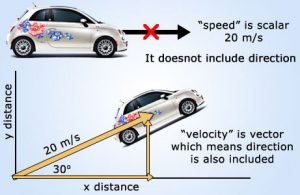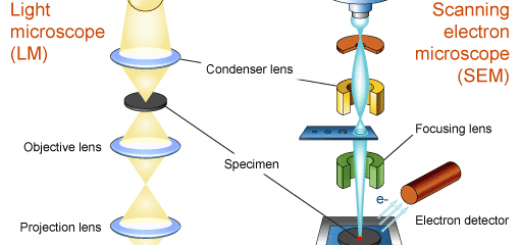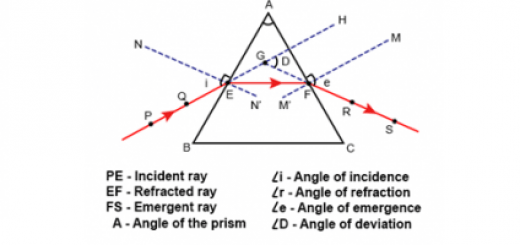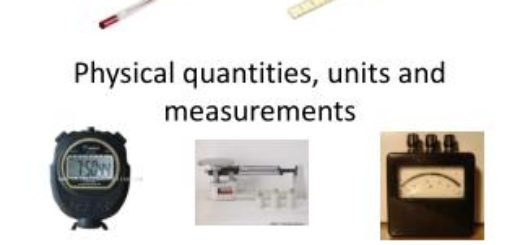Scalar Quantities, Vector Quantities & Finding resultant of two perpendicular forces
Physical quantities can be classified into Scalar and Vector Quantities , Scalar quantity is a physical quantity that can be fully defined by its magnitude only & it has no direction while Vector quantity is a physical quantity that can be fully defined by both magnitude and direction .
Examples of Scalar quantity : Distance , Mass , Time , Temperature & Energy , Examples of Vector quantity : Displacement , Velocity , Acceleration & Force .
When measuring a physical quantity such as Temperature ( The magnitude of temperature say , 27 ° C describes temperature fully ) , Velocity ( A value of 20 km/h does not describe fully the velocity of a car such that the direction of the car motion should be defined ) .
Distance and Displacement
There is a difference between the concept of displacement and the concept of distance , Distance is the length of the path moved by an object from a position to another , Distance is a scalar quantity that can be fully defined by its magnitude only .
Displacement is the length of the straight line segment in a given direction between the starting point and the end point , Displacement is a vector quantity that can be fully defined by its magnitude and direction .
Guidelines to solve problems
- If an object moves in one direction from A to B , the magnitude of displacement equals the distance covered .
- If an object moves in one direction from A to B then returns back to A , the magnitude of displacement = 0 and the distance covered = 2 AB .
- If an object moves in a curved path from A to B , Displacement would be shorter than distance .
- If an object moves in one direction from A to B and then reverses its direction to C , then the displacement ( d ) = AB – BC , The distance ( s ) = AB + BC .
Representation of vector quantities
The vector quantity is represented by a directed straight segment ( → ) whose base is at the starting point and its tip is at the end point , where its length is proportional to the vector magnitude , The arrow direction points to the direction of the vector quantity , The vector quantity is denoted by a bold letter ( A ) or a letter tagged by a small arrow .
Some basics & vector algebra
Two vectors are equal when they have the same magnitude and the same direction ( even if they have different starting points ) , Two vectors are not equal when they have different directions ( even if they have the same magnitude ) or different magnitudes ( even if they the same direction ) .
Vector Algebra
Vector Algebra such as Vectors addition , Vector resolution , Vector product ( Scalar ( dot ) product and Cross product ) .
Resultant ( addition ) of vectors
When two forces or more act on an object , this object would move in a certain direction determined by the resultant of these forces , The resultant force is a single force that produces the same effect on an object as that produced by the original acting forces .
Application
If a rock is pulled by two ropes with two forces of 30 N and 40 N having an angle 90° between them , We notice that the rock is moved a certain distance in a direction different than those of the two forces ( during a certain time ) .
If the two ropes are replaced by one rope and pulled by a force of 50 N , We notice that the rock is moved through the same distance in the same direction when it is affected by the two forces during the same time .
This means that the force 50 N produces the same effect as that of the two forces 30 N and 40 N , So , it is considered the resultant of the two forces 30 N and 40 N .
There are two ways to add two vectors by drawing a triangle and by drawing a parallelogram in which A and B are adjacent sides , Thus , the diagonal represents their resultant .
Finding the resultant of two perpendicular forces
First : Graphically
- Draw a horizontal line ( AB ) , on the graph paper , of length 3 cm to represent the first force ( F1 = 3 N ) .
- Perpendicular to ( A B ) at the point ( A ) , draw a vertical line ( AD ) of length 4 cm to represent the second force ( F2 = 4 N ) .
- Complete the rectangle ABCD .
- Join the diagonal ( AC ) to represent the magnitude and direction of the resultant .
- Measure the length of the line segment ( AC ) that represents the magnitude of the resultant force .
- Measure the angle ( BAC ) that defines the direction of the resultant force relative to the first force ( F1 ) .
Second : Theoretically
Find the magnitude of the resultant force using Pythagoras’ theorem for the right angled triangle ( AC² = AB² + BC² ) .
F² = F1² + F2²
We can find the angle ( θ ) by the relation
tan θ = Fy / Fx = F2 / F1
Resolution of a vector
Resolution of a vector is the reverse operation for getting the resultant of some vectors where a force can be resolved into two perpendicular forces along dimensions ( x , y ) , Thus :
Fy = F sin θ
Fx = F cos θ
Product of vectors
There are different forms of finding the product of two vectors :
Scalar ( dot ) product
The dot product of two vectors A and B is expressed as follows :
A . B = A B cos θ
The sign ( . ) is pronounced ” dot ” , The result is a scalar quantity .
The work is a scalar quantity as it is the dot product of two vectors which are force and displacement , W = F . d , If the vector ( F ) acts on the vector ( d ) at angle ( θ ) .
W = F D cos θ
Vector ( cross ) product
The cross product of two vectors A and B is expressed as follows :
C = A ^ B = A B sin θ n
Where n is a unit vector perpendicular to the plane of both vectors A and B , The sign ( ^ ) is pronounced cross and the result is a vector quantity C , The vector C points to the direction of n perpendicular to the plane of both vectors A and B .
The operation of the electric motor depends on the presence of two vectors which are electric field and magnetic field , while they cause the rotation of the motor coil in a direction perpendicular to the plane of them both .
The right hand rule
It is used to define the direction of the vector product C of two vectors A and B .
How to apply ?
Move the fingers of the right hand from the first vector towards the second vector through the smaller angle between them θ , the thumb then points to the direction of their vector product .
Static objects , Moving objects , Types of Motion and Velocity




